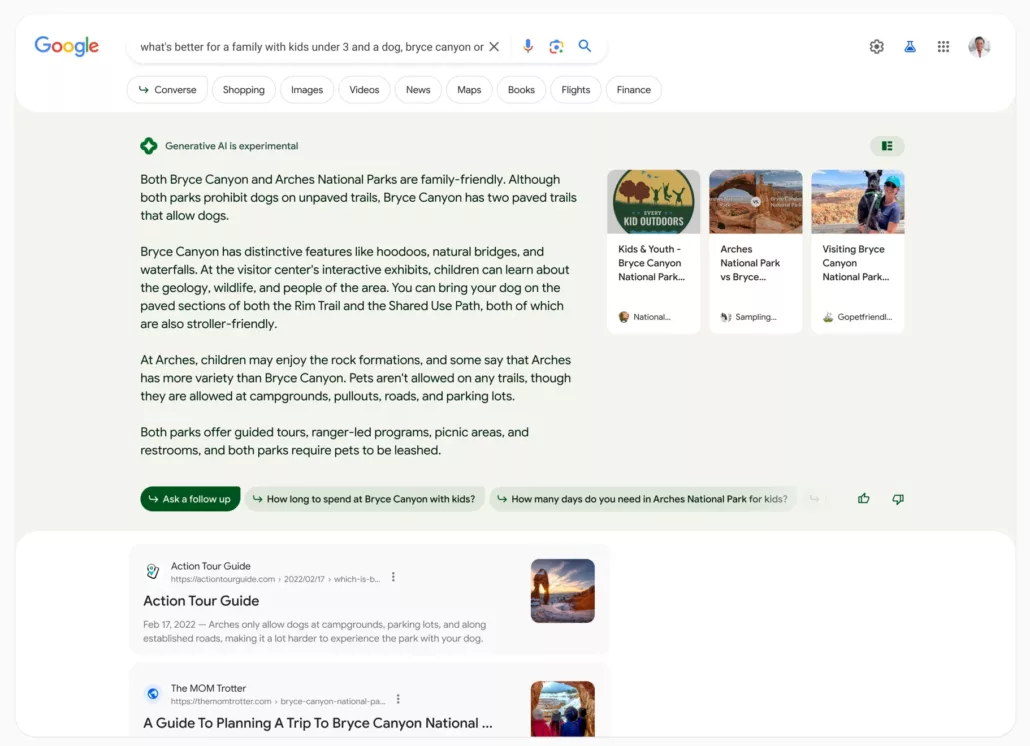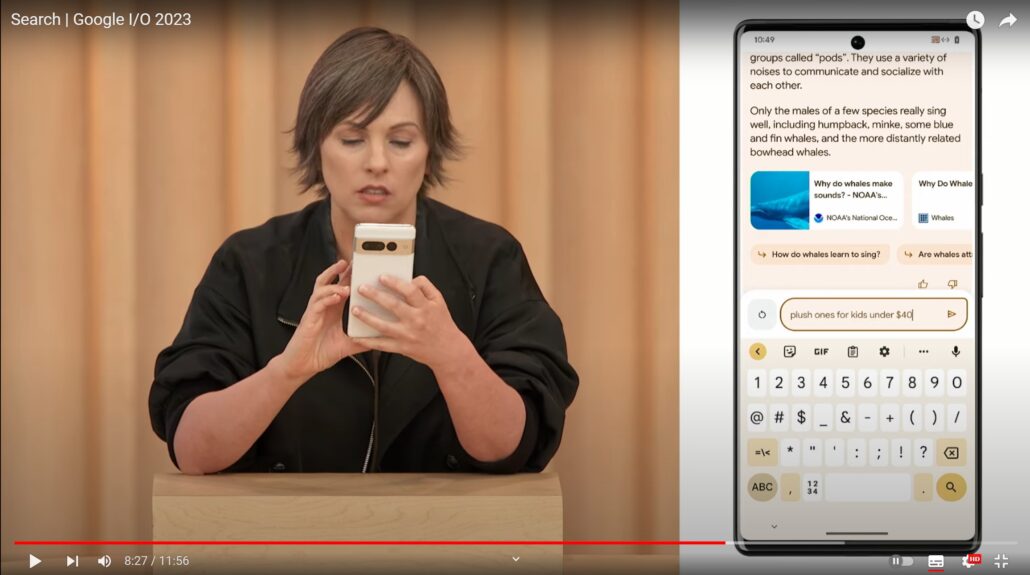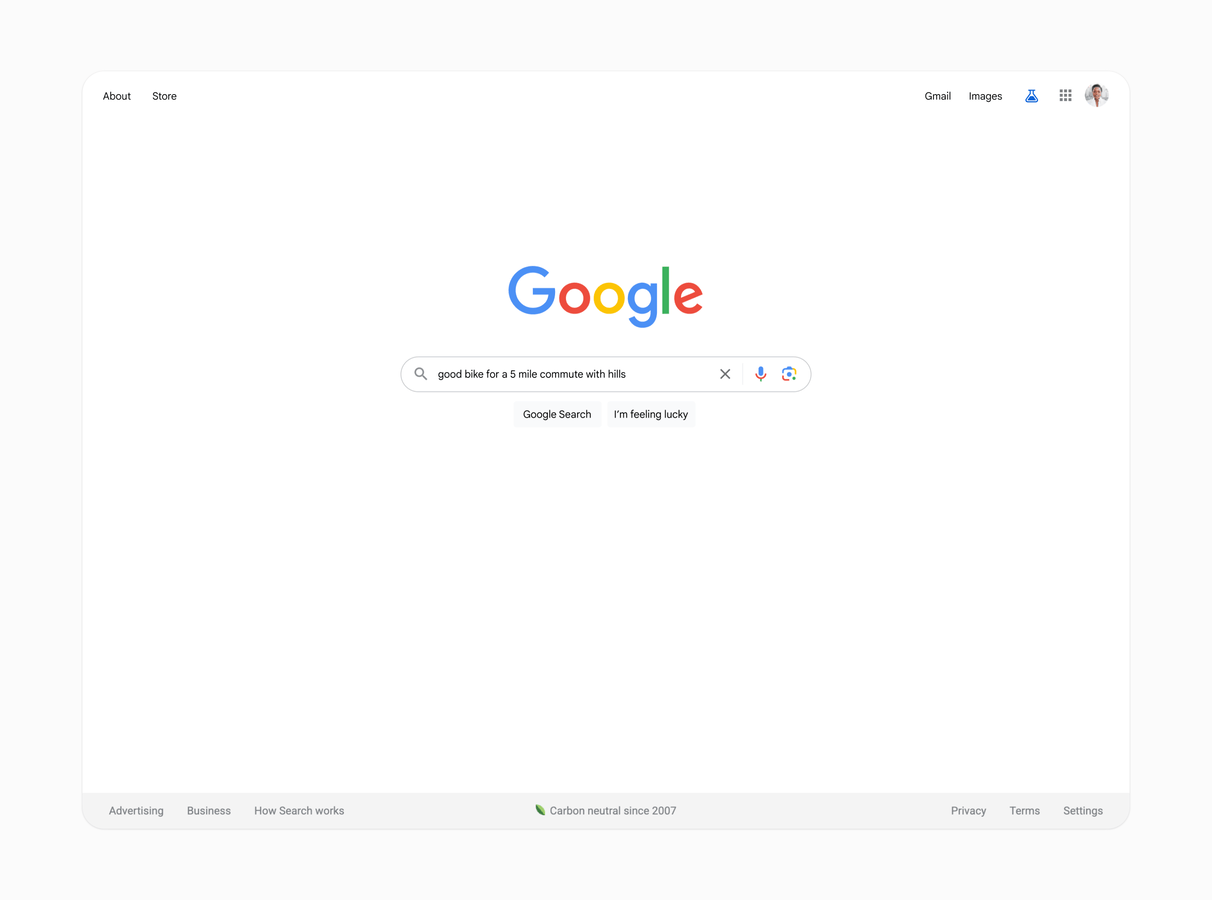A LOT has been said about Google’s new Search Generative Experience since it was announced last month, and as we eagerly await access to its experimental phase within Google Search Labs. Let’s delve into the initial impressions, post-initial impressions, and the wider community feedback surrounding this search experience change, which has had the wider SEO community talking non-stop!
[If you want to get a true understanding of SGE from a very top level perspective, I highly recommend reading this piece on Wordstream which explains SGE in the most simple way possible.]
Search with generative AI – SGE (Search Generative Experience)
Google made an exciting announcement at Google I/O 23′ with the launch of Search Generative Experience (SGE). This experimental feature utilises artificial intelligence (AI) to provide direct answers to user queries within the search results page. In essence, SGE is basically an enhanced iteration of Bing’s integration with OpenAI in their search results.
- Unlike Bard, which is open to access and operates differently, SGE’s output is within search results
- Still in development, so can change a lot based on feedback. Labelled as “Experimental”
- Not widely available (sign up for the waitlist) but many in the US have access.
SGE (Search Generative Experience) in a nutshell:
- AI snapshot: SGE uses AI, that generates a unique summary for some longer queries
- Conversational mode: Answers follow-up questions while retaining the context of the original search
- Vertical experiences: Provides a preferred list of features and more product details in commercial searches
Reference: Google
AI snapshot:
- Provides unique multi-angle query responses
- Simultaneous extraction from multiple unlinked sources
- Prominent display of three links with thumbnails alongside each snapshot
- Potential integration with product feed and shopping graph (get over 1.8 billion live updates per hour)
- Unknowns: Tracking performance, potential negative impact on informational and brand traffic, and potential positive impact of product feed and shopping graph.
Conversational mode:
- Contextual answers to follow-up questions within the search context
- Recommendations and results influenced by previous search history
- Anticipated increase in extra-long search queries and potential opportunities with product feed integration
- Unknowns: Tracking, utilisation, and potential positive impact of product feed and shopping graph.
Vertical experiences:
- Crucial for multi-angle shopping and local searches
- Enhanced feature list and provides detailed product information in commercial searches results
- Substantial impact on PPC by integrating ads and organic results within the expansive shopping graph data which includes over 38 million products
- Very important to have visually optimised product detail pages (PDPs) and product listing pages (PLPs) to drive traffic, emphasising on relevant images, descriptive content, and specificity of end products.
Experiments and insights/commentary shared by industry leaders:
- Aleyda Solís highlights that SGE almost replicates the experience of a product listing page (PLP), encompassing a product pack, description, and relevant links, anticipating an increase in traffic for product detail pages (PDPs).
In a different post, however, Aleyda demonstrated that in its current instance of SGE, established brand retailers’ PLPs will lose organic search traffic that won’t likely only go to their own PDPs but also to other online stores offering the product. This is traffic that they pretty much own, going to the brand retail PLP. This means [Brand Name] + [Product Line/Category Name] related queries are likely to see big competition from retailers’ results featuring generative AI.
- Lily Ray, I must admit, scared the hell out of me with the revelation for Brand name queries, when from some early experiments, a brand name showed a generative result with a description of the brand but no direct link to the brand in embedded or referred sources. This not only feels like it’s killing the purpose of the query, it’s simply bad User Experience.
My worries only lasted a couple of weeks, when she posted results of a similar test again, only this time, SGE wouldn’t generate an AI response for a brand name. Relief!
- Kevin Indig observed AI-generated answers are aggressively displayed in the e-commerce sector (Google utilises 2 rows, featuring seven products on desktop and two products on mobile devices). Particularly for transactional queries, attributes are extracted from product reviews, on-site content, or third-party retailers to structure the AI-generated answer.
- Brodie Clark highlighted the advantages of SGE’s AI-driven `product grids”, emphasising that traditional SERPs typically placed product listings below the fold. However, with SGE, these listings are prominently featured within the AI response, offering increased real estate and visibility. This can potentially lead to higher click-through rates (CTR), benefiting brands.
How does it impact, and what does it mean for e-commerce?
- The Ads format/location (inherited from existing paid campaigns) sits on top + generative AI below. It’s unclear how this will be tracked from a performance standpoint, but understandably may or may not be the best format for every sector.
- Tracking is a big unknown across paid/organic – you can’t opt out for ads and organically there is no GSC filter as yet that can determine the impression/click share this brings to the site. Barry Schwartz did ask Cathy Edwards from Google about the GSC filter, maybe he can elaborate on the response?
- AI traffic across instances may bring higher conversion rates as searchers may be higher-intent buyers
- The impact on organic traffic is fairly visible, considering generative results are prioritised over organic. On the mobile screen, it fills up an entire scroll thus you’re technically on page 2. Some minor referral traffic when the source is cited in the thumbnails is definitely a positive.
- Brand name queries impact – from some early experiments by Lily Ray, a brand name shows a generative result with a description of the brand but no direct link to the brand in embedded or referred sources. While this no longer appears, one wonders if this will remain as is or be different across brand names in general.
- Occasional poor answers, advice – a critical piece about SGE on Tom’s Hardware was summarised by Cyrus Shepard referring to the experience filled with “Plagiarism Stew”, faulty advice, and no authority/trust thus giving poor answers.
This is still a very selective pool but when its roll-out is global and publicly available, we can anticipate big volumes of poor results which are likely to be sending low quality traffic.
What can we do proactively or reactively?
As we anticipate the open launch of SGE experiment, it is crucial to maintain focus on core SEO principles like quality content, optimal site infrastructure and technical performance, however some key opportunities are to:
- Optimise PDPs/PLPs to align with user intent.
- Enhance visual appeal and optimise images site wide.
- Optimised product feeds, when triggered by organic queries are ideal for bonus traffic
- Implement relevant Schema, including Product, Ratings & Reviews, Org, Local, etc., for well-structured content.
Despite being in the early stages and labelled experimental, Google’s SGE demonstrates substantial potential, fuelled by extensive AI adoption and competition with search engines like Bing and will dominate the landscape of search engine results pages (SERPs) in the long term.
As agencies and SEOs, we have to stay informed and adhere to best practices. Initially, obtaining access to Search Labs is crucial, and then we need to continue to learn/identify patterns to ensure we deliver the best experience for consumers, and the best results for our brands.






